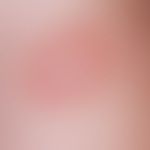Synonym(s)
Chinese wattle; Gugo; herpes farinosus; Indian lichen; lichen oriental; oriental lichen; Scaly Ringworm; superficial trichophytia corporis; Tamana; Tinea circinata tropicalis; Tokelau; Trichophytia corporis superficialis imbricata
HistoryThis section has been translated automatically.
William Dampier, 1789 (Island of Mindanao/Philippines)
DefinitionThis section has been translated automatically.
Special form of Tinea corporis superficialis with typical cocard-like flocks. "Imbricata" is derived from the Latin term "imbrex" = overlapping roof tiles.
You might also be interested in
PathogenThis section has been translated automatically.
Trichophyton concentricum (anthropophilic fungus that typically spares hair and nails).
Occurrence/EpidemiologyThis section has been translated automatically.
Occurs mainly in tropical regions, especially in Africa, South America or Asia (especially Vietnam). Tinea imbricata is endemic to the Philippines and Indonesia.
EtiopathogenesisThis section has been translated automatically.
A genetically predisposed increased sensitivity to T. concentricum (hereditary defect of cell-mediated immunity) is suspected.
ManifestationThis section has been translated automatically.
Infection often occurs in childhood. So far there are no reports of cases before the age of two.
LocalizationThis section has been translated automatically.
Located mainly on the trunk. Palmae and Plantae remain mostly free.
ClinicThis section has been translated automatically.
Brownish, peripherally migrating, very loose, hardly adherent, scaly, itchy, anular skin changes. Little or no erythema. Older lesions show signs of lichenification and usually itch less than fresh lesions.
DiagnosisThis section has been translated automatically.
Fungus detection: native preparation of potassium hydroxide solution, periodic acid staining (PAS) of the ship in the histological preparation, cultural identification of the pathogen (white-yellowish colonies with a powdery border wall and brown underside).
TherapyThis section has been translated automatically.
Terbinafine 1 time/day 250 mg for 4 weeks is effective and safe in the therapy of T. imbricata. The therapeutic success lasts at least 8 weeks. Griseofulvin is therefore an effective and inexpensive therapy. Itraconazole 200 mg/day p.o. for 1 week can be seen as an alternative.
Progression/forecastThis section has been translated automatically.
Spontaneous remissions are rare.
LiteratureThis section has been translated automatically.
- Budimulja U (1994) A double-blind, randomized, startified controlled study of the treatment of tinea imbricata with oral terbinafine or itraconazole. Br J Dermatol 130: 29-31
- Halde C et al (1965) Tinea imbricata treated with griseofulvin. Am J Trop Med Hyg 14: 1062-1065
- Wingfield AB et al (2004) Treatment of tinea imbricata: a randomized clincal trial using griseofulvin, terbinafine, itraconazole and fluconazole. Br J Derm 150: 119-126
Incoming links (10)
Achromia parasitica; Chinese lichen; Gugo; Indian lichen; Lichen, oriental; Scaly ringworm; Tamana; Tinea circinata tropicalis; Tokelau; Trichophytia corporis superficialis imbricata;Disclaimer
Please ask your physician for a reliable diagnosis. This website is only meant as a reference.




